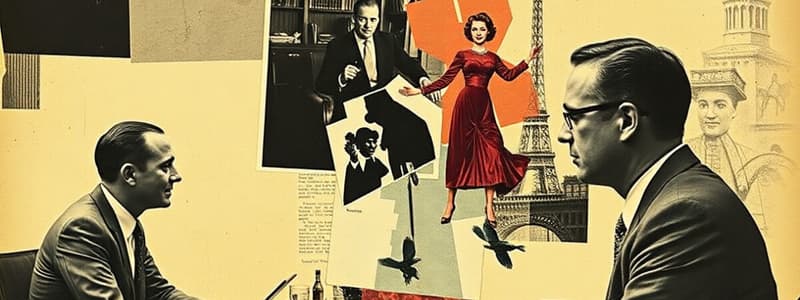Podcast
Questions and Answers
Which factor does NOT typically influence a manager's choice of management style?
Which factor does NOT typically influence a manager's choice of management style?
- The current stock price of the company (correct)
- The personality of the manager
- The nature of the tasks to be performed
- The skills and experience of employees
In an autocratic management style, communication flows primarily from employees to the manager.
In an autocratic management style, communication flows primarily from employees to the manager.
False (B)
Define 'autocratic' management style, in your own words.
Define 'autocratic' management style, in your own words.
Autocratic management is a leadership style where the manager makes all decisions independently, dictating tasks and methods to employees without seeking input.
In a(n) ______ management style, employees might feel undervalued due to lack of input in decision making.
In a(n) ______ management style, employees might feel undervalued due to lack of input in decision making.
Match each characteristic with the appropriate management style:
Match each characteristic with the appropriate management style:
Which leadership style is characterized by the leader dictating objectives but persuading employees on how to achieve them?
Which leadership style is characterized by the leader dictating objectives but persuading employees on how to achieve them?
In a laissez-faire leadership style, the leader retains the final decision-making authority while still considering employee input.
In a laissez-faire leadership style, the leader retains the final decision-making authority while still considering employee input.
Which leadership style involves sharing decision-making responsibilities, potentially leading to optimal decisions but also possible conflicts?
Which leadership style involves sharing decision-making responsibilities, potentially leading to optimal decisions but also possible conflicts?
In a _______ leadership style, a manager seeks input from employees to broaden the range of ideas considered before making a final decision.
In a _______ leadership style, a manager seeks input from employees to broaden the range of ideas considered before making a final decision.
Match the leadership style with its primary communication characteristic:
Match the leadership style with its primary communication characteristic:
Which of the following is a potential disadvantage of the consultative leadership style?
Which of the following is a potential disadvantage of the consultative leadership style?
A key benefit of the persuasive leadership style is the increased creativity and individual responsibility fostered among employees.
A key benefit of the persuasive leadership style is the increased creativity and individual responsibility fostered among employees.
Which leadership style is most likely to lead to a misuse of resources due to a lack of guidance?
Which leadership style is most likely to lead to a misuse of resources due to a lack of guidance?
Flashcards
Management Style
Management Style
The way a manager makes decisions, leads, and communicates with employees.
Management Styles Continuum
Management Styles Continuum
A spectrum from task-focused (manager control) to employee-focused (employee empowerment).
Autocratic Management
Autocratic Management
The leader dictates objectives and how to achieve them, with one-way communication.
Autocratic Advantages
Autocratic Advantages
Signup and view all the flashcards
Autocratic Disadvantages
Autocratic Disadvantages
Signup and view all the flashcards
Persuasive Leadership
Persuasive Leadership
Signup and view all the flashcards
Advantage of persuasive leadership
Advantage of persuasive leadership
Signup and view all the flashcards
Disadvantage of persuasive leadership
Disadvantage of persuasive leadership
Signup and view all the flashcards
Consultative Leadership
Consultative Leadership
Signup and view all the flashcards
Advantage of Consultative Leadership
Advantage of Consultative Leadership
Signup and view all the flashcards
Disadvantage of Consultative Leadership
Disadvantage of Consultative Leadership
Signup and view all the flashcards
Participative Leadership
Participative Leadership
Signup and view all the flashcards
Laissez-Faire Leadership
Laissez-Faire Leadership
Signup and view all the flashcards
Study Notes
- Management style refers to how a manager makes decisions, leads, and communicates with employees.
- There are five main management styles: autocratic, persuasive, consultative, participative, and laissez-faire.
- The choice of management style depends on factors like the manager's personality, employee skills, task nature, and available time.
- Management styles range from task-centered (manager-focused) to employee-centered (employee-empowered), forming a continuum.
- Control decreases and employee involvement increases as you move along the continuum from left to right.
Autocratic
- Autocratic management involves the leader dictating objectives and how to achieve them.
- Communication is one-way, from leader to employee, with the manager retaining decision-making power.
- A key advantage is efficient time usage due to no discussion or consultation.
- A key disadvantage is that it can result in poor morale, as the manager retains control and decision making and employees may feel undervalued.
Persuasive
- The leader still dictates objectives but attempts to persuade employees about how they should be achieved.
- Communication remains one-way.
- Morale may be maintained better than with an autocratic style.
- A key disadvantage is that the business can miss on ideas and insights due to a lack of employee input, potentially leading to less informed decisions.
- A further disadvantage is potential employee feelings of manipulation due to being "sold" ideas.
Consultative
- The leader asks employees for their opinions before making a decision in this style.
- Communication is two-way.
- A key advantage is a broader pool of ideas for enhanced decision-making.
- Seeking employee input boosts satisfaction and motivation.
- A key disadvantage is that time taken to consult can slow down the decision-making process.
- There can be resentment if employee suggestions are ignored or some employees may lack relevant experience.
Participative
- The leader shares decision-making responsibility with their team.
- Communication is two-way.
- Decisions are made by the group.
- A key advantage is recognizing employee skills and empowering them to make decisions.
- Teamwork should lead to optimum final decisions.
- A key disadvantage is that making and discussing everyone's views can be very time-consuming.
- Conflict may arise if decisions are disregarded.
Laissez-Faire
- Employees are totally responsible for decision-making and the operation of the business.
- Communication is two-way.
- Decisions are made by the employees.
- A key advantage is high trust and empowerment for employees, fostering creativity and motivation.
- A key disadvantage could be a loss of control or conflicts over business direction and objectives.
- There is potential for misuse of resources due to lack of guidance.
Studying That Suits You
Use AI to generate personalized quizzes and flashcards to suit your learning preferences.




